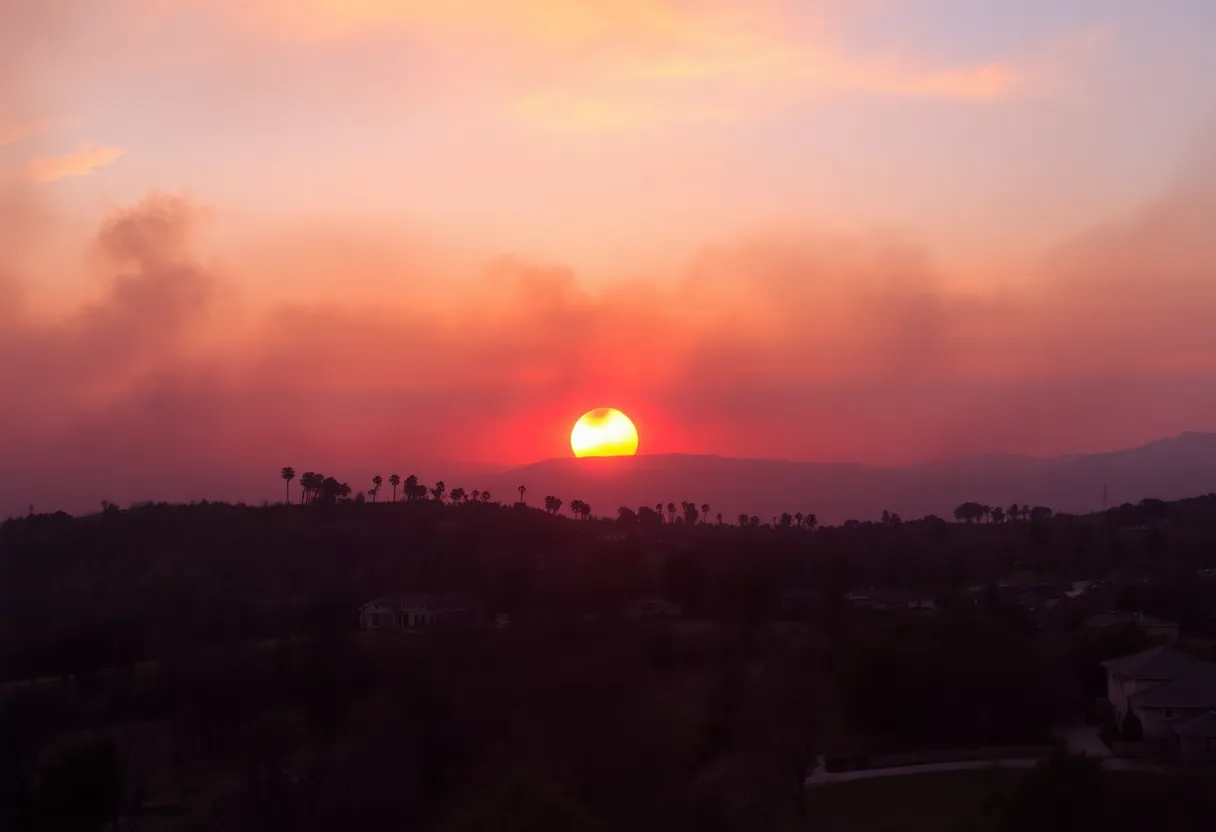News Summary
Southern California is battling a wildfire crisis that has the potential to become the most destructive in U.S. history. With economic losses potentially reaching $3 billion, high-value areas in Los Angeles and surrounding counties are being severely impacted. Many homeowners are considering relocation instead of rebuilding, which could drastically alter the housing market. As recovery efforts face various hurdles, including labor shortages and contamination issues, the future remains uncertain for both the economy and residents of this affected region.
Southern California Faces Unprecedented Wildfire Crisis
As the sun sets over Los Angeles, the glow of chaos continues to rise from the ongoing wildfires in Southern California. These blazes are not just the usual summer trouble; they’re on track to become the most destructive wildfires in U.S. history, with potential losses that might reach a staggering $3 billion. It’s a tough time for many, as the fires uncomfortably creep through prime real estate in the heart of Los Angeles, Riverside, San Bernardino, and Ventura counties.
High-Value Areas in the Line of Fire
What’s particularly alarming is that these flames aren’t just licking the trees and brush as we’ve seen in past fires; they are targeting densely populated and high-value areas, leaving behind a trail of destruction that takes a toll on the local economy and community. Unlike previous wildfire catastrophes, most of the current damage is happening in rich neighborhoods where rebuilding costs will be astronomical. It’s no wonder that people are anxious about what the future holds for their homes, priced at more than double the national average.
The Ripple Effect on the Economy
Preliminary estimates suggest economic losses from the fires could soar above previous wildfire events. This could lead to a significant impact on the regional economy, while the national economy might feel just a ripple effect. What’s more, as the fires rage on, consumer activity in the region is already slipping. Restaurants in Los Angeles have seen reservations plummet by over 60% year-over-year, while luxury spots in Beverly Hills have suffered a sharp 50% drop. It’s not just about dining out; everyday life is disrupted, with power outages and water shortages making it tough for businesses and families alike.
The Housing Dilemma
For many homeowners, the thought of rebuilding is daunting. There’s chatter among some residents about simply relocating instead of attempting to rebuild, which could shift local housing demand significantly. These discussions come as rising wildfire-related insurance claims loom over homeowners, likely to push up premiums substantially – a troubling trend reminiscent of hurricane issues in Florida. Additionally, California’s FAIR Plan, which aims to provide fire insurance for high-risk properties, is facing challenges that may even require taxpayer funding. This adds yet another layer to the already tight housing market crisis that California is battling.
Factors Compounding the Recovery
Moreover, recovery efforts are not just hindered by wildfires; they’re also facing other hurdles. Federal immigration policies and tariffs on construction materials mean that labor shortages and increased costs might stall rebuilding progress even further.
A New Hope in Fire-Resilient Communities
On a more optimistic note, innovation is shining through the despair. In Escondido, a new community has emerged that is nothing short of a miracle – the first fire-resilient community in the nation, complete with fire-resistant construction and landscaping methods. This could potentially lower insurance costs and increase property values in regions frequently threatened by wildfires. Insurers are expected to look more favorably upon homes built with such advanced features, and it may prompt them to offer discounts to homeowners who follow suit with certified wildfire-prepared homes.
Challenges and the Long-Term Outlook
Sadly, the situation doesn’t end there. As significant collaborations among utility companies and local officials strive to bury power lines and minimize fire hazards while rebuilding, ever more serious questions linger about homes that somehow managed to survive. Many of these structures are believed to be contaminated by ash and debris. Plus, the presence of lithium-ion batteries from destroyed electric vehicles becomes another worm in the apple, complicating cleanup due to potential re-ignition hazards.
Some residents are taking matters into their own hands, opting to pay out of pocket for toxic contaminant testing on their properties as it seems there are no clear governmental guidelines in place just yet.
Conclusion
With over 11,000 homes burned down and 37,000 acres turned to ash in these fires, the rebuilding journey ahead promises to be long and winding. As the flames continue to wreak havoc, the future holds uncertainty for Southern California’s economy, housing market, and, importantly, the safety of its residents.
Deeper Dive: News & Info About This Topic
- USA Today: First Fire-Resilient Community in California
- Wikipedia: Wildfire
- ABC7: Palisades Fire Rebuilding Efforts
- Google Search: Southern California Wildfires
- CBS News: California Wildfire Cleanup
- Encyclopedia Britannica: Wildfire
- The Guardian: California Wildfires and Oldest Tree
- Google News: California Wildfire Cleanup
- KCRA: Los Angeles Wildfires Death Toll Rises
- Google Scholar: Wildfires Impact

Author: STAFF HERE HUNTINGTON BEACH
The Huntington Beach Staff Writer represents the experienced team at HEREHuntingtonBeach.com, your go-to source for actionable local news and information in Huntington Beach, Orange County, and beyond. Specializing in "news you can use," we cover essential topics like product reviews for personal and business needs, local business directories, politics, real estate trends, neighborhood insights, and state news affecting the area—with deep expertise drawn from years of dedicated reporting and strong community input, including local press releases and business updates. We deliver top reporting on high-value events such as the Huntington Beach Surf City USA Marathon, the U.S. Open of Surfing, Fourth of July celebrations at the Huntington Beach Pier, and community festivals at Huntington Beach Central Park. Our coverage extends to key organizations like the Huntington Beach Chamber of Commerce and Visit Huntington Beach, plus leading businesses in retail, hospitality, and outdoor recreation that drive the local economy. As part of the broader HERE network, including HEREAnaheim.com, HERECostaMesa.com, HERESantaAna.com, and HERELosAngeles.com, we provide comprehensive, credible insights into Southern California's dynamic landscape.





